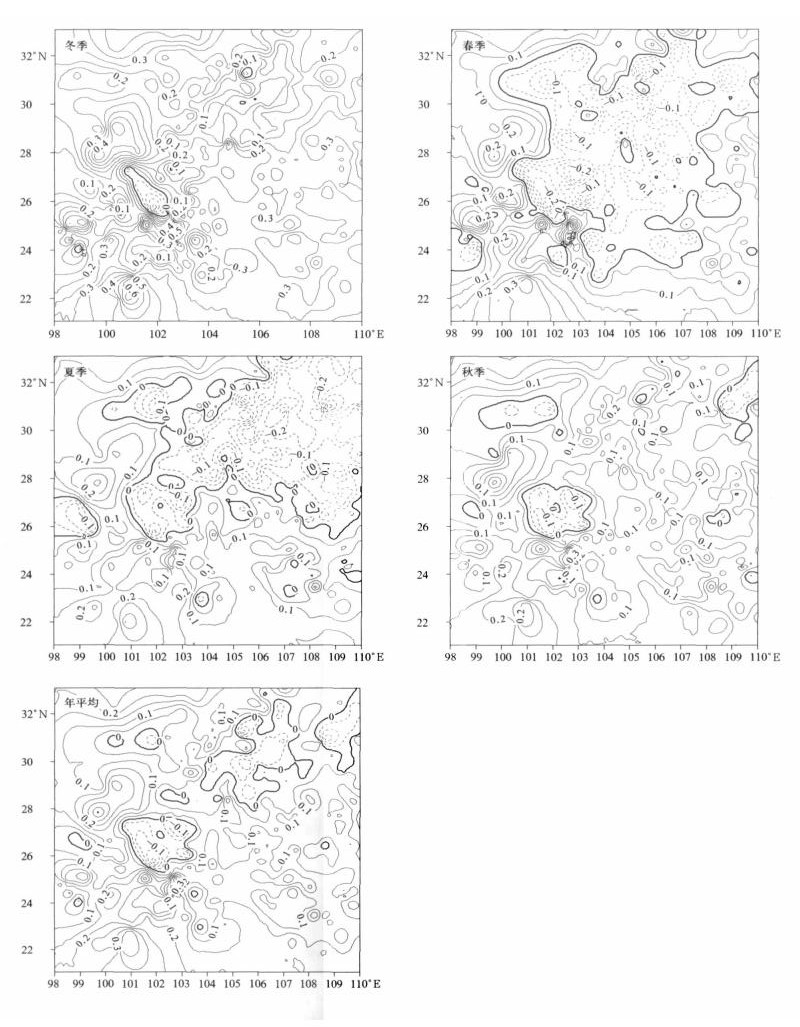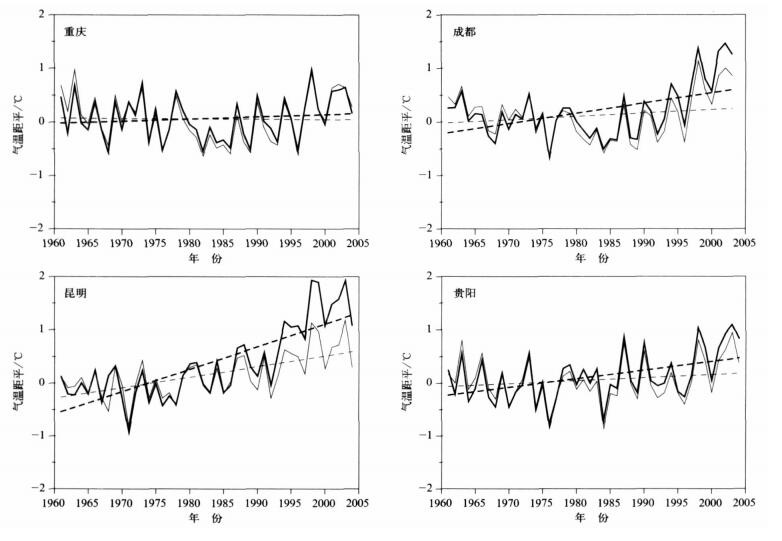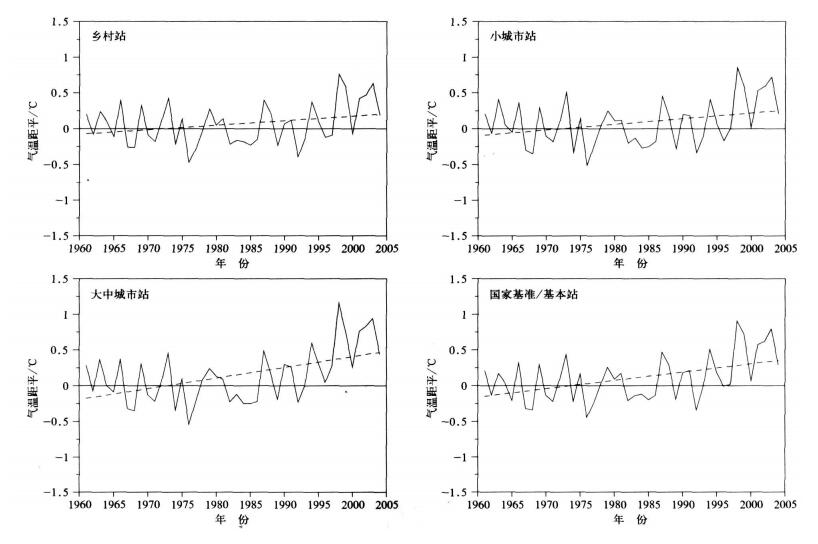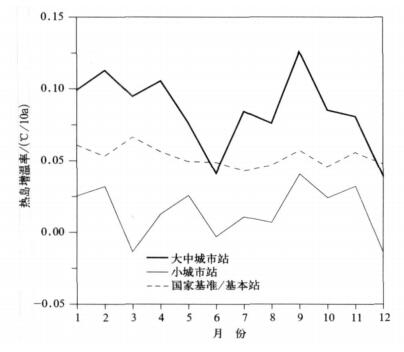西南地区城市热岛强度变化对地面气温序列影响
Change of Urban Heat Island Intensity and Its Effect on Surface Mean Air Temperature Records in Southwest China
-
摘要: 利用1961—2004年我国西南地区322个站的气温观测资料, 分析了乡村站、小城市站、大中城市站和国家基准/基本站气温变化趋势特点, 着重研究了城市化对城镇站和国家站地面气温记录的影响程度和相对贡献比例。结果显示:区域平均的各类台站年平均气温呈现不同程度的上升趋势, 城市站、国家站的增温速率均高于乡村站。大中城市站和国家站的年平均热岛增温率分别为0.086 ℃/ 10a和0.052 ℃/10a, 其增温贡献率分别达57.6%和45.3%。与大多数地区不同, 西南地区的增温速率明显偏小。因此, 尽管平均热岛强度变化比许多地区弱, 但其相对贡献明显, 表明城市化对该区域气温趋势的绝对影响较弱, 但相对影响较强。另外, 城市热岛增温有明显的季节变化, 表现为秋季最强, 春季或冬季次之, 夏季最弱。热岛增温贡献率则为春季最大 (100%), 夏季次之 (73%以上), 秋季和冬季相对较小。这主要是因为春、夏两季背景气候变凉或趋势微弱, 热岛增温在实际增温中占有更高的比例。Abstract: The surface air temperature records are obviously affected by the urbanization in China.The changes of the surface air temperature in Southwest China lag behind the countrywide changes, and air temperature records at some stations even show a dropping trend.It is important to understand the detailed features of surface air temperature change trends and the effect on them of urban development for different stations in that region.Using a data set of monthly mean temperature from 322 stations and corresponding population data, the surface air temperature change trends and the effect of urbanization development on mean surface air temperature records in towns and cities in Southwest China during 1961—2004 are analyzed.Quality control and inhomogeneity adjustment are made for air temperature data.On the basis of calculating air temperature change trends of towns and cities at national reference/baseline stations and rural stations, the extent and relative contribution proportion of urbanization effect are obtained by comparing the differences between the change trends of various stations and rural stations.Results show that there are warming trends of surface air temperature for each of the station groups.The warming rates in towns and cities, and national stations are greater than those in rural areas.In annual mean surface air temperature records in towns and cities, and national stations, urban warming rates are estimated as 0.086 ℃/10a and 0.052 ℃/10a respectively, and their contributions to overall annual mean temperature change are 57.6% and 45.3% respectively.Compared with the other regions in China, the warming rates of temperature and the urban warming rates in Southwest China are relatively low.Although the change of the average heat island intensity in this region is smaller than those in quite a number of regions in China, the contributions of urban warming to the overall mean temperature change trends are generally larger as a result of this feature.In addition, there are obvious season changes in urban warming rates, with the urban warming rates in autumn, spring or winter being the largest and second respectively, and that in summer the smallest. However, the largest contributions (100%) of urban warming to mean temperature in seasons are in spring, second to which are the contributions in summer of 73% and above.Those in autumn and winter are relatively smaller.
-
表 1 1961-2004年西南地区城市代表站与郊区站年平均气温增温对比
Table 1 Comparison of annual mean temperature warming rates between urban areas and suburbs in Southwest China for 1961-2004

表 2 1961-2004年西南地区各类气象台站平均气温变化速率及城市站与国家站热岛增温率和贡献率
Table 2 Trends of surface air temperature, the heat island warming rates of city station and reference/basic station and their contributions to mean temperature change in Southwest China for 1961-2004

-
[1] IPCC. Climate Change 2001 : Science Basis. Cambridge: Cambridge University Press, 2001 [2] IPCC. Climate Change 2007: Science Basis. Cambridge: Cambridge University Press, 2007 [3] Hansen J R Lebedeff. Global trends of measured surface temperature. J GeophysRes, 1987, 92 (13): 345-372 doi: 10.1029/JD092iD11p13345/abstract [4] Karl T R, Diaz H F, Kukla G. Urbanization:Its detection and effect in the United States climate record. J Climate, 1988, 1:1099-1123 doi: 10.1175/1520-0442(1988)001<1099:UIDAEI>2.0.CO;2 [5] Karl T R, Jones P D. Urban bias in area-averaged surface air temperature trends. Bull Amer Meteor Soc, 1989, 70:265-270 doi: 10.1175/1520-0477(1989)070<0265:UBIAAS>2.0.CO;2 [6] Balling R C, Idso S B. Historical temperature trends in the United States and the effect of urban population growth. J Geophys Res, 1989, 94 : 3359-3363 doi: 10.1029/JD094iD03p03359 [7] Karl T R, Jones P D. Comments on "Urban bias in area-averaged surface air-temperature trends" reply to GM Cohen. Bull Amer Meteor Soc, 1990, 71 : 571-574 [8] Goodridge J D. Urban bias influences on long-term California air temperature trends. Atmosp Environ, 1992, 26B (1) : 1-7 http://www.sciencedirect.com/science/article/pii/095712729290032N [9] Hughes W E, Bailing R C. Urban influences on South African temperature trends. Int J Climatol, 1996, 16 : 935-940 doi: 10.1002/(ISSN)1097-0088 [10] Wang W C, Zeng Z, Karl T R. Urban heat islands in China. Geophys Res Lett, 1990, 17:2377-2380 doi: 10.1029/GL017i013p02377 [11] 赵守慈.近39年中国的气温变化与城市化影响.气象, 1991, 17(4):14-16 http://www.cnki.com.cn/Article/CJFDTOTAL-QXXX199104003.htm [12] 林学椿, 于淑秋, 唐国利.北京城市化进程与热岛强度关系的研究.自然科学进展, 2005, 15(7):882-886 http://www.cnki.com.cn/Article/CJFDTOTAL-ZKJZ200507024.htm [13] 初子莹, 任国玉.北京地区城市热岛强度变化对区域温度序列的影响.气象学报, 2005, 63(4):534-540 http://www.cnki.com.cn/Article/CJFDTOTAL-QXXB200504014.htm [14] 陈棒妹.兰州的城市热岛效应.高原气象, 1991, 10(1):83-87 http://www.cnki.com.cn/Article/CJFDTOTAL-GYQX199101009.htm [15] 哈斯.城市效应对呼和浩特市气候的影响.气候与环境研究, 2000, 5(2):228-232 http://www.cnki.com.cn/Article/CJFDTOTAL-QHYH200002016.htm [16] 刘学锋, 阮新, 谷永利.石家庄地区气温变化和热岛效应分析.环境科学研究, 2005, 18(5):11-14 http://www.cnki.com.cn/Article/CJFDTOTAL-HJKX200505002.htm [17] 田武文, 黄祖英, 胡春娟.西安市气候变暖与城市热岛效应问题研究.应用气象学报, 2006, 17(4):438-443 http://qikan.camscma.cn/jams/ch/reader/view_abstract.aspx?file_no=20060474&flag=1 [18] 周雅清, 任国玉.华北地区地表气温观测中城镇化影响的检测和订正.气候与环境研究, 2005, 10(4):743-753 http://www.cnki.com.cn/Article/CJFDTOTAL-QHYH200504005.htm [19] 张爱英, 任国玉.山东省城市化对区域平均温度序列的影响.气候与环境研究, 2005, 10(4):743-753 http://www.cnki.com.cn/Article/CJFDTOTAL-QHYH200504006.htm [20] 方锋, 白虎志, 赵红岩, 等.中国西北地区城市化效应及其在增暖中的贡献率.高原气象, 2007, 26(3):579-585 http://www.cnki.com.cn/Article/CJFDTOTAL-GYQX200703019.htm [21] 王绍武.近百年我国及全球气温变化趋势.气象, 1990, 16(2):11-15 http://www.cnki.com.cn/Article/CJFDTOTAL-QXXX199002002.htm [22] 唐国利, 林学椿.1921—1990年我国气温序列及变化趋势.气象, 1992, 18(7):3-6 http://www.cnki.com.cn/Article/CJFDTOTAL-QXXX199207002.htm [23] 丁一汇, 戴晓苏.中国近百年来的温度变化.气象, 1994, 20(12):19-26 http://www.cnki.com.cn/Article/CJFDTOTAL-QXXX412.006.htm [24] 林学椿, 于淑秋,唐国利.中国近百年温度序列.大气科学, 1995, 19(5):525-534 http://www.cnki.com.cn/Article/CJFDTOTAL-DQXK505.001.htm [25] 王绍武, 叶瑾琳 , 龚道溢,等.近百年中国年气温序列的建立.应用气象学报, 1998, 9(4):392-401 http://qikan.camscma.cn/jams/ch/reader/view_abstract.aspx?file_no=19980459&flag=1 [26] 唐国利, 任国玉.近百年中国地表气温变化趋势的再分析.气候与环境研究, 2005, 10(4):791-798 http://www.cnki.com.cn/Article/CJFDTOTAL-QHYH200504010.htm [27] 陈隆勋, 邵永宁, 张清芬, 等.近四十年我国气候变化的初步分析.应用气象学报, 1991, 2(2):164-173 http://qikan.camscma.cn/jams/ch/reader/view_abstract.aspx?file_no=19910215&flag=11 [28] 中国统计局.中国乡、镇、街道人口资料.北京:中国统计局出版社, 2002:1-482 [29] 任国玉, 徐铭志, 初子莹, 等.近54年中国地面气温变化.气候与环境研究, 2005, 10(4):717-727 http://www.cnki.com.cn/Article/CJFDTOTAL-QHYH200504002.htm [30] 丁一汇, 任国玉.中国气候变化科学概论.北京:气象出版社, 2008:1-281. -


 设为首页
设为首页 加入收藏
加入收藏



 下载:
下载:




